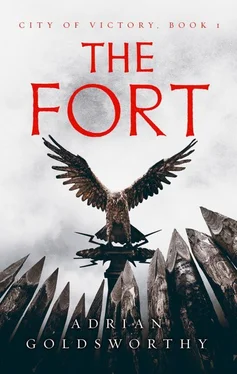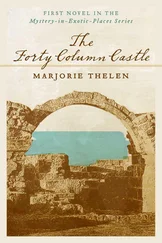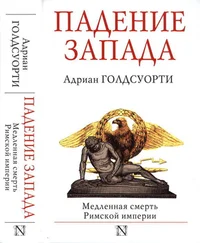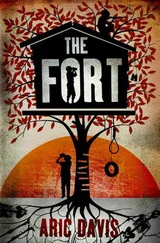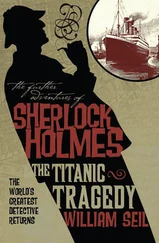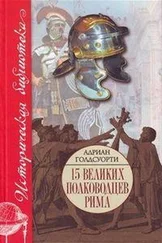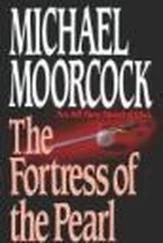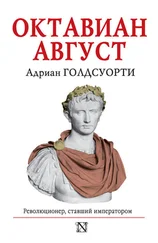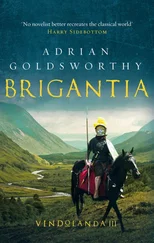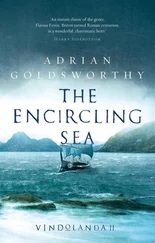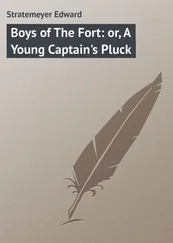‘From all I hear, my lord, our princeps is shrewd enough to appreciate true talent.’
Hadrian chuckled. ‘Perhaps it runs in the family. Now, I have more work to do and you need to go.’
‘One request, sir. The two Brigantes who came in with me. I’d like to see them before I go.’
‘Ah, that was regrettable. I fear their heads are on spearpoints above the camp’s gateway.’
‘What?’ Ferox shouted, hands gripping the arms of the chair.
Hadrian banged his fist onto the table. ‘Mind your manners, centurion! A reliable source told me that you were duped by those men, for they had been sent by Decebalus to murder the emperor, getting close by posing as deserters returned to the fold. Another group of deserters has been arrested and executed in the last few days, for it seems that the king sent several, anticipating the emperor’s arrival.’
‘They were good men, and I do not believe that they were traitors.’
‘What you believe is neither here nor there, centurion. The evidence was clear, and I for one will never take an unnecessary risk when there is a threat to the emperor’s life.’ Hadrian’s voice was as level as it was unrelenting.
Still Ferox did not believe a word of it or doubt that Sosius was the source or at least had provided the justification. Presumably unmasking the alleged plot would be another way for Hadrian to show his ability and loyalty. Already flush with the victory over Diegis and the relief of the garrison, uncovering a plot was bound to add to the emperor’s favour. No wonder Hadrian was confident that he would receive the post of governor of the new province.
The legate had calmed and was watching him, one hand rubbing his bearded chin. Even if Ferox tried to tell the truth and was believed, Hadrian would be seen as overzealous in his enthusiasm to preserve the emperor’s life, even if sadly mistaken. He would still get his province and Trajan’s favour and if Ferox spoke up then he hurt Claudia badly, and might ruin the life of Sulpicia Lepidina and his son. Trajan had made a great show of enforcing the adultery laws with severity, especially when anyone of senatorial family was involved. It was imagination, no more, but Ferox felt the cut to his arm throbbing for he knew that he had failed the men who had sworn to him and that there was no chance of vengeance now or perhaps ever.
‘May I have their bodies, my lord, to honour after the manner of their tribe?’ he asked.
‘Sorry, they went in the river.’ Hadrian reached for a papyrus and unrolled it on his table. After a moment he glanced up. ‘Anything else, centurion?’
‘No, sir. Other than to say that you really are a bastard, aren’t you?’
Hadrian smiled, for he had won. ‘You would have had to ask my parents about that, I suppose. But in the sense that you meant, I would hope so. Rome needs bastards in charge, as long as they are clever. Now close the tent flap as you leave and go and write your letter. I shall read it, of course, before it is delivered, so please bear that in mind. Good luck to you, Flavius Ferox. I should not bother to make you one of my men unless I had the highest opinion of your worth. When they are recovered I will probably send you some of your Brigantes to command. They strike me as handy men. Together you will do great things in the service of Rome and that is a noble end even if the means are sometimes ignoble. Now go!’
Ferox limped out of the tent. The camp was bustling as army camps always were, and the sentries on duty were immaculately turned out. A trumpet sounded for the start of the third watch.
‘ Omnes ad stercus ,’ he said under his breath, and went to write to his wife.
The Fort is a novel, its plot and the majority of the characters either wholly fictional or greatly embellished from the little known about their real predecessors. However, I have done my best to set the story in as accurate a context as possible, given our limited sources for this era. More details of the sources can be found at my website, adriangoldsworthy.com
Trajan’s Dacian Wars were major conflicts, eventually resulting in the acquisition by Rome of the new province of Dacia, its heartland in modern-day Romania. Conquests on this scale were fairly rare after the death of Augustus, Rome’s first emperor, in AD 14. Rarely did a Roman emperor want to spend years off on campaign outside the empire, and even more rarely did they trust anyone else to do this for them, lest they become a dangerous rival. Trajan was one of the few exceptions and has gone down in history as a great soldier, who spent almost a third of his reign on campaign. As far as we can tell, his military record before he became emperor was fairly modest and a large part of his quest for military glory came from a desire to justify his rather weak claim to rule. Dacia, a former enemy who had inflicted several humiliating defeats on the Romans in recent memory, offered an ideal opportunity for an aggressive and glorious war.
Trajan’s First Dacian War (AD 101–102) brought victories and was widely celebrated, but left Decebalus of Dacia in charge of much of his kingdom. The Second War (AD 105–106) resulted in the abolition of the kingdom, the suicide of Decebalus, and the formal creation of the Roman province (which was subsequently divided into three provinces). Both wars required the commitment of substantial numbers of Roman troops, with perhaps a fifth or even a quarter of the entire army involved and an even higher proportion of legions contributing detachments or vexillations. Warfare on this scale was expensive, but Dacia, rich in mineral resources, especially gold, which appears to have been a royal monopoly, was a great prize.
The loot from Dacia funded the construction of Trajan’s Forum in the heart of Rome itself, enough of which is still visible to give an idea of its grand and lavish scale. At its heart was Trajan’s Column, 93’ high on a 20’ pedestal, decorated with carved reliefs telling the stories of the two wars – it was claimed that the height was to show how much earth had been excavated from the hillside to permit the construction of the complex. The sculptures are very detailed, depicting soldiers marching, parading and sacrificing, building roads and forts, and fighting battles and sieges. In most cases weapons were added as bronze miniatures, long since plundered and recycled so that apart from a few carved swords and bows, men wave empty hands at each other. Much is stylised, so that ships and buildings are shown on a smaller scale than the figures. Trajan is prominent, but depicted as only slightly larger than everyone else – this is no great king smiting his feeble foes. Legionaries are marked out as clearly distinct from the regular auxiliaries, let alone the irregulars, and everyone is dressed as an audience in Rome would expect, rather than with strict accuracy, so that the Dacians in the main are generic barbarians, with shaggy hair, beards and baggy tunics and trousers. Debate continues to rage over the accuracy of the scenes.
Trajan wrote an account of his campaigns as Commentaries , just like those written by Julius Caesar. However, only a single line from this has survived. Nothing at all has survived directly from the many other accounts celebrating the victories, or from narratives of the earlier campaigns under the Emperor Domitian. All we have are a handful of fragments, and the only remotely complete account is provided by writers of the Byzantine period, who summarised the fuller account written by the senator Cassius Dio in the early third century AD. What we have is brief and at times confused and we have no real idea how much fuller or reliable the original was.
Thus the Dacian Wars, for all their scale and importance, are very poorly known. Archaeology helps to a degree, not least in giving more sense of Dacian society, culture and the sophistication of their architecture, as well as the establishment of Roman forts and subsequently cities. Excavation is rarely suited to helping us to understand the faster moving events of individual campaigns and instead reveals longer term trends. At fort sites, attention naturally focuses on the later, more permanent phases of occupation, usually built in stone, rather than the initial establishment of a base. Trajan’s Column clearly tells a detailed story, presenting the official line and quite possibly representing in art many of the incidents Trajan had described in his Commentaries . Yet it is rather like trying to understand the Bayeux Tapestry, but without the captions and with very skimpy knowledge of the history of 1066.
Читать дальше
